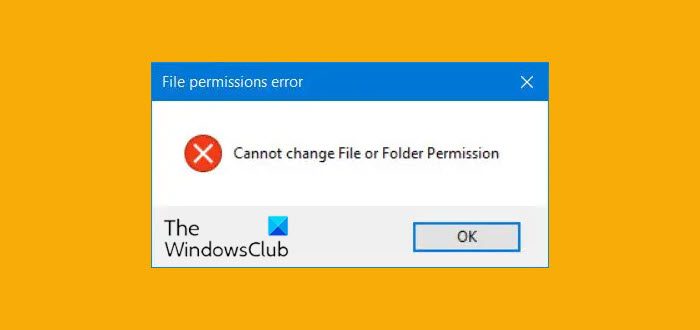In Windows 11/10, whenever you create a new file or folder, the Windows operating system assigns it a set of default permissions, called Effective Permissions. You may at times, want to or need to change these permissions.

Cannot change File or Folder Permission in Windows
But if for some reason, you cannot set custom permissions, for files or folders, here are some things you can try, depending on your symptoms.
- If the Security tab is not visible: If you can see only the Sharing tab and NOT the Security tab, check the Properties for that drive. The Security tab is visible only on NTFS drives and will NOT be visible if you are using the FAT file system.
- If Checkmarks disappear even after you have made and saved the changes: If you have set permissions and then apply them to anything, other than the default location, (this Folder, Subfolder & Files) Windows Vista and later adds a checkmark in the Special Permissions box. You can now view the applied permissions by clicking Advanced > Edit > selecting the User / Group > Click Edit. You may have to scroll to the bottom of the Permissions list to view it.
- You find that the checkmarks for some users are shaded and in the Permissions dialog box, the checkboxes for those users are unavailable: Such permissions are inherited from the folder in which the file/folder is stored, and not set explicitly. To break the inheritance chain, you have to, in the Security Tab, click ‘Advanced’ in the ‘Advanced Security Settings’ box, then click Edit and finally clear ‘Include Inheritable Permissions From Objects Parent’.
- If the Permission settings are not available: You need to check your user account rights. Are you logged in as a member of the Administrators group? Or are you the owner of the object, to set its permissions? If you are logged in as a Standard user, you will be able to view only your own permission settings. If you select another user/group on the Security tab, the permissions box would be unavailable.
If this does not help you, you can use DropPermission to instantly overcome this problem.
Read: How to check NTFS Permissions using Command-line or Free tools
For further troubleshooting, you may want to see this post on how to troubleshoot File and Folder Permission Issues.
See this post if you receive You’ll need to provide administrator permission to delete this folder error message.